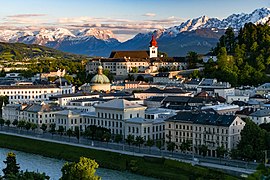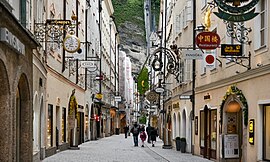Our website is made possible by displaying online advertisements to our visitors.
Please consider supporting us by disabling your ad blocker.
Salzburg
Salzburg | |
|---|---|
|
From top, left to right: view of Hohensalzburg Fortress, University of Salzburg in front of the Salzach, with Nonnberg Abbey in the background, Salzburg Cathedral, Roittner-Durchhaus, Getreidegasse | |
|
| |
| Coordinates: 47°48′0″N 13°02′0″E / 47.80000°N 13.03333°E | |
| Country | |
| State | Salzburg |
| District | Statutory city |
| Government | |
| • Mayor | Harald Preuner (ÖVP) |
| Area | |
| • Total | 65.65 km2 (25.35 sq mi) |
| Elevation | 424 m (1,391 ft) |
| Population (1 October 2020)[2] | |
| • Total | 157,245 |
| • Density | 2,400/km2 (6,200/sq mi) |
| Time zone | UTC+1 (CET) |
| • Summer (DST) | UTC+2 (CEST) |
| Postal code | 5020 |
| Area code | 0662 |
| Vehicle registration | S |
| Website | www |
| UNESCO World Heritage Site | |
|---|---|
 | |
| Criteria | Cultural: ii, iv, vi |
| Reference | 784 |
| Inscription | 1996 (20th Session) |
| Area | 236 ha |
| Buffer zone | 467 ha |
Salzburg (Austrian German: [ˈsaltsbʊɐ̯k]; German: [ˈzaltsbʊɐ̯k] (![]() listen);[note 1] literally "Salt Fortress"; Austro-Bavarian: Soizbuag) is the capital and also a district of the Austrian state of Salzburg or Salzburgerland. The population is about 150,000 and is the 4th largest city of Austria.
listen);[note 1] literally "Salt Fortress"; Austro-Bavarian: Soizbuag) is the capital and also a district of the Austrian state of Salzburg or Salzburgerland. The population is about 150,000 and is the 4th largest city of Austria.
Its most famous citizen was Wolfgang Amadeus Mozart. Another famous inhabitant of Salzburg was the physicist Christian Doppler who found the Doppler effect which was named after him.
The Salzach river crosses the city. The old town was adopted by the UNESCO as World Heritage Site in 1996. Known is Salzburg also for being one of the settings for the movie "The Sound of Music" which based on the musical by Richard Rodgers and Oscar Hammerstein.
- ↑ "Dauersiedlungsraum der Gemeinden Politischen Bezirke und Bundesländer - Gebietsstand 1.1.2018". Statistics Austria. Retrieved 10 March 2019.
- ↑ "Salzburg in Zahlen". Archived from the original on June 24, 2020. Retrieved June 23, 2020.
- ↑ "Salzburg". Oxford Dictionaries UK Dictionary. Oxford University Press. Retrieved 29 May 2019.
- ↑ "Salzburg". Collins English Dictionary. HarperCollins. Retrieved 29 May 2019.
- ↑ "Salzburg". The American Heritage Dictionary of the English Language (5th ed.). Boston: Houghton Mifflin Harcourt. Retrieved 29 May 2019.
- ↑ "Salzburg". Merriam-Webster Dictionary. Retrieved 29 May 2019.
<ref group=note> tags on this page, but the references will not show without a {{reflist|group=note}} template (see the help page).
Previous Page Next Page












